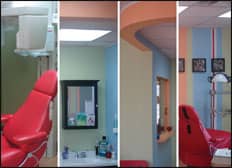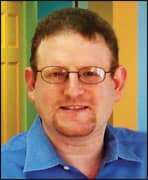by Seth Marguiles, DDS
A new orthodontist chats about opening his first practice
 |
Orthodontic Products: Tell me your history: where did you go to school, and when did you start your practice?
Seth Marguiles, DDS: I went to the NYU College of Dentistry Orthodontics department for my residency program. I graduated in August 2008 and opened up my practice in October 25, 2008.
OP: What was the first thing you did after deciding to open your own practice?
SM: I found a location where I wanted to open up: Perth Amboy, New Jersey.
OP: What kind of research did you do to decide on that location?
 |
| Seth Marguiles, DDS |
SM: I did a little bit of demographic research. There was a company that actually did it for me, OrthoSynetics. I did not end up signing a contract with them, but part of the courting period was that they would do a demographic search for me. The nice things about the area were [that there were] no other full-time orthodontists in the city, there are 50,000 people, and the city is going through a gentrification period. So it was getting better, not worse.
OP: So you chose the area in which you wanted to set up your practice and then you went looking for real estate?
SM: Before I really started looking at real estate, I made sure that I had the availability for financing lined up. After that I started looking for real estate.
OP: And how was the shopping process looking for financing?
SM: Well, there are several companies that market directly to dental and dental specialties practices. I reviewed what each one had to offer. Based on ease of use and the people who I was working with I chose to use Henry Schein Financial to help me find a loan. And they connected me with ChoiceHealth.
OP: What did Henry Schein offer as opposed to other companies that made you go that way?
SM: I felt like there was someone negotiating on my behalf, as opposed to me doing all the talking. They coordinate the financing.
OP: How did you choose exactly where your practice would be located?
SM: I looked at a few places. I looked at some retail spaces and I looked at some office building spaces, and I just looked for a place where I could see myself for the next 5 years.
OP: What type of space did you end up renting?
SM: I am in a professional office building.
OP: What was the move-in process like? How much building and adding was done?
SM: I had a space analysis done by Ross Orthodontics. They basically evaluated my space. And then Henry Schein designed the spaces and Ross kind of drew it out. And then I had my architect finish up the plans. After that I went to five or six contractors to find out how much it would cost. I selected my contractor, and then I started construction in September.
OP: So you had Ross do a space analysis, and then Henry Schein did some of the planning, and then you had an architect. Why did you choose that path as opposed to getting a specialty architect?
SM: I was trying to control my cost. So everything I did was to control cost. Ross had a very good “new grad” deal to do the space analysis. Henry Schein does design and draws in the mechanical for free if you spend a certain amount with them, and I was already going to be using them for my equipment anyway. So basically, that was free. And my architect, if I gave him the raw material it was a lot easier for him, so he didn’t charge me as much. The way I see it, if you go to a specialist who does a lot of this stuff—yes, they do it well and everything up to paint colors they come up with, but you spend a lot more money on that service.
OP: Is the office themed in any way? Or is it just a standard orthodontic office?
SM: It is a fairly standard orthodontic office. It is brightly colored; it has an open bay and a private consultation room, a lab, a sterilization area. The one area where I gave up a little is that I don’t have a private office. But hopefully I’m not sitting in a private office too long anyway.
OP: And how many chairs total?
SM: Five chairs.
OP: So you have your space, and then I guess your next step is staff?
SM: Well, staff is another issue entirely—we’re still working on that one. I have one person answering a phone, a family member, there 4 days a week. And he’s my only staff at the moment.
OP: And are you hoping to change from that?
SM: Well, yes, eventually I am hoping to change it. But I’d like to get some patients started before I really start hiring people. Equalize my revenue stream to my output.
OP: How many starts have you had since opening?
SM: Since opening October 25, I’ve had about eight starts.
OP: Do you have a goal for what you’d like your production to be a couple of years down the line?
SM: So far I have several consults lined up, and this year I’d like to start 50 to 80 patients.
OP: What planning has gone into that number?
SM: That number will equalize my revenues to my cost and allow me to continue at 1 to 2 days in my office per week. This number of patients will allow me to continue at that.
OP: And where else are you working?
SM: I work at four other orthodontic offices in New Jersey.
|
For complete information on all the companies mentioned here, visit our online Buyer’s Guide. |
OP: Have other issues come up in the process of opening your own practice that you didn’t think of?
SM: No, not really. I think you just have to be prepared and ask a lot of questions. Persevere. If you don’t get the right answer, look somewhere else.
Seth Marguiles, DDS, is in private practice in Perth Amboy, NJ. He can be reached at References
- O’Brien K, Lewis D, Shaw W, Coombe E. A clinical trial of aligning archwires. Eur J Orthod. 1990;12:380-384.
- West AE, Jones ML, Newcombe RG. Multiflex versus superelastic: a randomised clinical trial of the tooth alignment ability of initial archwires. Am J Orthod Dentofacial Orthop. 1995;108:464-471.
- Evans TJW, Jones ML, Newcombe RG. Clinical comparison and performance perspective of three aligning archwires. Am J Orthod and Dentofacial Orthop. 1998;114:32-39
- Weiland F. Constant versus dissipating forces in orthodontics: the effect on initial tooth movement and root resorption. 2003;25(4):335-342.
- Kusy RP. Nitinol alloys: So, who’s on first? Am J Orthod Dentofac Orthop (Letters to the Editor). 1991;100:25A-26A.
- Burstone CJ, Qin B, Morton JY. Chinese Ni-Ti wire: a new orthodontic alloy. Am J Orthod. 1985;87:445-452.
- Miura F, Mogi M, Ohura Y, Hamanaka H. The superelastic properties of the Japanese Ni-Ti alloy wire for use in orthodontics. Am J Orthod Dentofacial Orthop. 1986;90:1-10.
- Santoro M, Nicolay OF, Cangialosi TJ. Pseudoelasticity and thermoelasticity of nickel-titanium alloys: a clinically oriented review. Part I. Temperature transitional ranges. Am J Orthod Dentofacial Orthop. 2001;119:587-593.
- Santoro M, Nicolay OF, Cangialosi TJ. Pseudoelasticity and thermoelasticity of nickel-titanium alloys: a clinically oriented review. Part II. Deactivation forces. Am J Orthod Dentofacial Orthop. 2001;119:594-603.
- Santoro M, Beshers DN. Nickel-titanium alloy: stress-related temperature transitional range. Am J Orthod Dentofacial Orthop. 2000;118:685-692.
- American National Standard/American Dental Association Specification No. 32: Orthodontic Wires. Chicago, III: American Dental Association; 2000.









